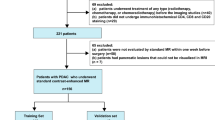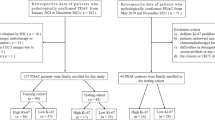Abstract
Purpose
To develop and validate a machine-learning classifier based on contrast-enhanced computed tomography (CT) for the preoperative prediction of CD20+ B lymphocyte expression in patients with pancreatic ductal adenocarcinoma (PDAC).
Methods
Overall, 189 patients with PDAC (n = 132 and n = 57 in the training and validation sets, respectively) underwent immunohistochemistry and radiomics feature extraction. The X-tile software was used to stratify them into groups with ‘high’ and ‘low’ CD20+ B lymphocyte expression levels. For each patient, 1409 radiomic features were extracted from volumes of interest and reduced using variance analysis and Spearman correlation analysis. A multilayer perceptron (MLP) network classifier was developed using the training and validation set. Model performance was determined by its discriminative ability, calibration, and clinical utility.
Results
A log-rank test showed that the patients with high CD20+ B expression had significantly longer survival than those with low CD20+ B expression. The prediction model showed good discrimination in both the training and validation sets. For the training set, the area under the curve (AUC), sensitivity, specificity, accuracy, positive predictive value, and negative predictive value were 0.82 (95% CI 0.74–0.89), 92.42%, 57.58%, 0.75, 0.69, and 0.88, respectively; whereas these values for the validation set were 0.84 (95% CI 0.72–0.93), 86.21%, 78.57%, 0.83, 0.81, and 0.85, respectively.
Conclusion
The MLP network classifier based on contrast-enhanced CT can accurately predict CD20+ B expression in patients with PDAC.







Similar content being viewed by others
References
Siegel RL, Miller KD, Jemal A. Cancer statistics, 2020. CA Cancer J Clin. 2020; 70(1):7-30.
Kommalapati A, Tella SH, Goyal G, Ma WW, Mahipal A. Contemporary Management of Localized Resectable Pancreatic Cancer. Cancers (Basel). 2018; 10(1).
Kleeff J, Korc M, Apte M, et al. Pancreatic cancer. Nat Rev Dis Primers. 2016; 2:16022.
Takahashi K, Ehata S, Koinuma D, et al. Pancreatic tumor microenvironment confers highly malignant properties on pancreatic cancer cells. Oncogene. 2018; 37(21):2757-72.
Ho WJ, Jaffee EM, Zheng L. The tumour microenvironment in pancreatic cancer - clinical challenges and opportunities. Nat Rev Clin Oncol. 2020; 17(9):527-40.
Ren B, Cui M, Yang G, et al. Tumor microenvironment participates in metastasis of pancreatic cancer. Mol Cancer. 2018; 17(1):108.
Wartenberg M, Cibin S, Zlobec I, et al. Integrated Genomic and Immunophenotypic Classification of Pancreatic Cancer Reveals Three Distinct Subtypes with Prognostic/Predictive Significance. Clin Cancer Res. 2018; 24(18):4444-54.
Xu YF, Lu Y, Cheng H, et al. Abnormal distribution of peripheral lymphocyte subsets induced by PDAC modulates overall survival. Pancreatology. 2014; 14(4):295-301.
Liu L, Zhao G, Wu W, et al. Low intratumoral regulatory T cells and high peritumoral CD8(+) T cells relate to long-term survival in patients with pancreatic ductal adenocarcinoma after pancreatectomy. Cancer Immunol Immunother. 2016; 65(1):73-82.
Yang C, Cheng H, Luo G, et al. The metastasis status and tumor burden-associated CA125 level combined with the CD4/CD8 ratio predicts the prognosis of patients with advanced pancreatic cancer: A new scoring system. Eur J Surg Oncol. 2017; 43(11):2112-8.
Shen T, Zhou L, Shen H, et al. Prognostic value of programmed cell death protein 1 expression on CD8+ T lymphocytes in pancreatic cancer. Sci Rep. 2017; 7(1):7848.
Tang R, Liu X, Liang C, et al. Deciphering the Prognostic Implications of the Components and Signatures in the Immune Microenvironment of Pancreatic Ductal Adenocarcinoma. Front Immunol. 2021; 12:648917.
Miligy I, Mohan P, Gaber A, et al. Prognostic significance of tumour infiltrating B lymphocytes in breast ductal carcinoma in situ. Histopathology. 2017; 71(2):258-68.
Kadota K, Nitadori JI, Ujiie H, et al. Prognostic Impact of Immune Microenvironment in Lung Squamous Cell Carcinoma: Tumor-Infiltrating CD10+ Neutrophil/CD20+ Lymphocyte Ratio as an Independent Prognostic Factor. J Thorac Oncol. 2015; 10(9):1301-10.
Hennequin A, Derangere V, Boidot R, et al. Tumor infiltration by Tbet+ effector T cells and CD20+ B cells is associated with survival in gastric cancer patients. Oncoimmunology. 2016; 5(2):e1054598.
Dong J, Li J, Liu S, et al. Prognostic potential of an immune score based on the density of CD8(+) T cells, CD20(+) B cells, and CD33(+)/p-STAT1(+) double-positive cells and HMGB1 expression within cancer nests in stage IIIA gastric cancer patients. Chin J Cancer Res. 2016; 28(5):543-52.
Edin S, Kaprio T, Hagstrom J, et al. The Prognostic Importance of CD20(+) B lymphocytes in Colorectal Cancer and the Relation to Other Immune Cell subsets. Sci Rep. 2019; 9(1):19997.
Cabrita R, Lauss M, Sanna A, et al. Tertiary lymphoid structures improve immunotherapy and survival in melanoma. Nature. 2020; 577(7791):561-5.
Wang WQ, Liu L, Xu HX, et al. Intratumoral infiltrating immune cells and gene mutations in pancreatic ductal adenocarcinoma. Br J Surg. 2016; 103(9):1189-99.
Brunner M, Maier K, Rummele P, et al. Upregulation of CD20 Positive B-Cells and B-Cell Aggregates in the Tumor Infiltration Zone is Associated with Better Survival of Patients with Pancreatic Ductal Adenocarcinoma. Int J Mol Sci. 2020; 21(5).
D'Angelo A, Sobhani N, Roviello G, et al. Tumour infiltrating lymphocytes and immune-related genes as predictors of outcome in pancreatic adenocarcinoma. PLoS One. 2019; 14(8):e0219566.
Arefan D, Hausler RM, Sumkin JH, Sun M, Wu S. Predicting cell invasion in breast tumor microenvironment from radiological imaging phenotypes. BMC Cancer. 2021; 21(1):370.
Kaissis GA, Ziegelmayer S, Lohofer FK, et al. Image-Based Molecular Phenotyping of Pancreatic Ductal Adenocarcinoma. J Clin Med. 2020; 9(3).
Attiyeh MA, Chakraborty J, McIntyre CA, et al. CT radiomics associations with genotype and stromal content in pancreatic ductal adenocarcinoma. Abdom Radiol (NY). 2019; 44(9):3148-57.
Moons KG, Altman DG, Reitsma JB, et al. Transparent Reporting of a multivariable prediction model for Individual Prognosis or Diagnosis (TRIPOD): explanation and elaboration. Ann Intern Med. 2015; 162(1):W1-73.
Verbeke FCCS. Pathology of the Pancreas: A Practical Approach2013.
Amin MB, Edge SB, Greene FL, et al. AJCC Cancer Staging manual. 8 ed. New York: Springer; 2017.
Watanabe H, Okada M, Kaji Y, et al. New response evaluation criteria in solid tumours-revised RECIST guideline (version 1.1). Gan To Kagaku Ryoho. 2009; 36(13):2495–501.
Tempero MA, Malafa MP, Al-Hawary M, et al. Pancreatic Adenocarcinoma, Version 2.2021, NCCN Clinical Practice Guidelines in Oncology. J Natl Compr Canc Netw. 2021; 19(4):439–57.
van Griethuysen JJM, Fedorov A, Parmar C, et al. Computational Radiomics System to Decode the Radiographic Phenotype. Cancer Res. 2017; 77(21):e104-e7.
Camp RL, Dolled-Filhart M, Rimm DL. X-tile: a new bio-informatics tool for biomarker assessment and outcome-based cut-point optimization. Clin Cancer Res. 2004; 10(21):7252-9.
Gunderson AJ, Kaneda MM, Tsujikawa T, et al. Bruton Tyrosine Kinase-Dependent Immune Cell Cross-talk Drives Pancreas Cancer. Cancer Discov. 2016; 6(3):270-85.
Lee KE, Spata M, Bayne LJ, et al. Hif1a Deletion Reveals Pro-Neoplastic Function of B Cells in Pancreatic Neoplasia. Cancer Discov. 2016; 6(3):256-69.
Pylayeva-Gupta Y, Das S, Handler JS, et al. IL35-Producing B Cells Promote the Development of Pancreatic Neoplasia. Cancer Discov. 2016; 6(3):247-55.
Roghanian A, Fraser C, Kleyman M, Chen J. B Cells Promote Pancreatic Tumorigenesis. Cancer Discov. 2016; 6(3):230-2.
Castino GF, Cortese N, Capretti G, et al. Spatial distribution of B cells predicts prognosis in human pancreatic adenocarcinoma. Oncoimmunology. 2016; 5(4):e1085147.
Tewari N, Zaitoun AM, Arora A, Madhusudan S, Ilyas M, Lobo DN. The presence of tumour-associated lymphocytes confers a good prognosis in pancreatic ductal adenocarcinoma: an immunohistochemical study of tissue microarrays. BMC Cancer. 2013; 13:436.
McGuigan AJ, Coleman HG, McCain RS, et al. Immune cell infiltrates as prognostic biomarkers in pancreatic ductal adenocarcinoma: a systematic review and meta-analysis. J Pathol Clin Res. 2021; 7(2):99-112.
Diana A, Wang LM, D'Costa Z, et al. Prognostic role and correlation of CA9, CD31, CD68 and CD20 with the desmoplastic stroma in pancreatic ductal adenocarcinoma. Oncotarget. 2016; 7(45):72819-32.
Meng Y, Zhang H, Li Q, et al. Noncontrast Magnetic Resonance Radiomics and Multilayer Perceptron Network Classifier: An approach for Predicting Fibroblast Activation Protein Expression in Patients With Pancreatic Ductal Adenocarcinoma. J Magn Reson Imaging. 2021.
Bian Y, Liu C, Li Q, et al. Preoperative Radiomics Approach to Evaluating Tumor-Infiltrating CD8(+) T Cells in Patients With Pancreatic Ductal Adenocarcinoma Using Noncontrast Magnetic Resonance Imaging. J Magn Reson Imaging. 2021.
Bracci S, Dolciami M, Trobiani C, et al. Quantitative CT texture analysis in predicting PD-L1 expression in locally advanced or metastatic NSCLC patients. Radiol Med. 2021.
Collins GS, Reitsma JB, Altman DG, Moons KG. Transparent reporting of a multivariable prediction model for individual prognosis or diagnosis (TRIPOD): the TRIPOD statement. BJOG. 2015; 122(3):434-43.
Vickers AJ, Elkin EB. Decision curve analysis: a novel method for evaluating prediction models. Med Decis Making. 2006; 26(6):565-74.
Funding
This work was supported in part by the National Science Foundation for Scientists of China (Grant Nos. 81871352, 82171915, 82171930), Clinical Research Plan of SHDC (Grant No. SHDC2020CR4073), 234 Platform Discipline Consolidation Foundation Project (Grant No. 2019YPT001), Shanghai Science and Technology Innovation Action Plan Medical Innovation Research Project (Grant No. 20Y11912500), and the Natural Science Foundation of Shanghai Science and Technology Innovation Action Plan (Grant Nos. 21ZR1478500, 21Y11910300).
Author information
Authors and Affiliations
Corresponding authors
Additional information
Publisher's Note
Springer Nature remains neutral with regard to jurisdictional claims in published maps and institutional affiliations.
Rights and permissions
About this article
Cite this article
Yu, J., Li, Q., Zhang, H. et al. Contrast-enhanced computed tomography radiomics and multilayer perceptron network classifier: an approach for predicting CD20+ B cells in patients with pancreatic ductal adenocarcinoma. Abdom Radiol 47, 242–253 (2022). https://doi.org/10.1007/s00261-021-03285-4
Received:
Revised:
Accepted:
Published:
Issue Date:
DOI: https://doi.org/10.1007/s00261-021-03285-4




